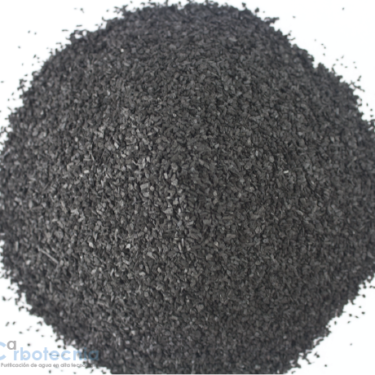Why is chlorine dioxide the only effective oxidant in the disinfection of granular activated carbon (GAC) beds used in water treatment plants?
What is the function of granular activated carbon (GAC) in a water treatment plant?
The activated carbon has two functions in a water treatment plant: adsorb (trap on its walls) the organic compounds present in the water and eliminate the residual oxidant that is used in order to disinfect it.
Adsorption of organic compounds on activated carbon
In all water obtained from nature (lake, river, well, rain, snowmelt) organic compounds are present in lesser or greater concentration. The increase in the production and use of synthetic materials has caused some of those to be relatively new to earth. Among them are solvents, fuels, pesticides, drugs, detergents, fats, oils, proteins …
Some of these compounds are harmful to humans and other species, even in small concentrations. They are, because we have not adapted to them. Among these, the potability parameters have been including those that show evidence of danger.
CAG is an adsorbent with a high nonspecific capacity to adsorb most organic compounds. This non-specificity means that it retains all kinds of compounds (as long as they fit in the pores of the carbon).
Removal of residual oxidant that was used in order to disinfect the water
As a rule, every water treatment train must include at least one disinfection stage. In most cases, the train starts by adding a biocidal agent to the water. This agent is usually an oxidant. The most used is Free chlorine.
Free chlorine, like any other biocide, requires certain amount of time to act. After disinfecting, a residual remains that must be removed to make the water potable.
GAC is not only an adsorbent. It is also a reducing agent. Therefore, it reacts with oxidizing compounds. It reduces Free chlorine (which is hypochlorous acid or hypochlorite ion) to chloride ion. For its part, the carbon involved in the reaction forms a surface oxide that ends up dissolving in the water in the form of carbonic acid.
C(s) + HOCl(l) -> CO(s) + H+ + Cl–
CO(s) + H2O(l) -> H2CO3(l)
H2CO3(l) -> H2O(l) + CO2(g)↑
Why should the GAC litter be disinfected in a water treatment plant?
The water that reaches the tank containing the CAG bed has a residual concentration of free chlorine. Therefore, it does not contain active microorganisms.
As you might expect, after this water has passed through the CAG bed, it is free of both organic matter and free chlorine. However, after a few days or weeks, this water shows a bacterial count. From that moment on, if the CAG bed is not disinfected, the effluent, in addition to carrying bacteria, will acquire a drainage smell.
If the water fed to the GAC tank does not contain active microorganisms, why after a certain time do these begin to appear in the treated water?
When the water treatment train is stopped, it is common for a vacuum to be generated by the line that feeds the water to the AGC tank, and this vacuum causes a back flow. Counter flow is water flow in the opposite direction to that of operation. This occurs when the water that feeds the AGC tank comes from a lower level, and when the following two circumstances also occur:
- The pump that makes the water flow into the GAC tank is stopped.
- The check valve installed in the water supply line to the AGC tank does not close properly.
This causes a vacuum that in turn produces the backflow in the water treatment train. In fact, when such a possibility exists, it is important to install vacuum breaker valves in water treatment trains, to prevent the tanks from collapsing in the event of a vacuum being caused (it should not be forgotten that containers designed to withstand pressure have almost zero resistance to vacuum).
In the event that backflow occurs, the CAG tank receives water that does not contain a residual concentration of the oxidizing agent. If there is a leak in the effluent line from the AGC tank or if the water receives microbial contamination at some point of discharge, the microorganisms reach the AGC bed. The charcoal offers them a rough surface, which is very suitable for anchoring. In addition, they find the organic matter that the CAG has adsorbed. At that moment, it starts playing.
When the water treatment process is put into operation again, disinfected water reaches the GAC bed again from the top. The residual chlorine disappears in the first few centimeters of bedding. This is so because the neutralization reaction between free chlorine and GAC is very fast. Therefore, in the middle and lower part of the bed, the water no longer has free chlorine, and the bacteria continue to reproduce.
Can the CAG litter be disinfected by backwashing with chlorinated water?
The backwash with chlorinated water they will inactivate the bacteria on the outside of the GAC particles at the bottom of the bed. This will decrease the bacteria content in the treated effluent. However, the free chlorine will not reach the bacteria lodged inside the charcoal crevices because it is neutralized on the outside. It also won’t reach the middle of the bed. From all this, disinfection of the CAG litter by backwash with chlorinated water it is not very effective. You may achieve temporary disinfection, but before long an unacceptable bacterial count reappears in the effluent. Superchlorination of backwash water (chlorination in higher concentrations) is also not effective.
Oxidizers other than free chlorine, such as ozone, chloramines, hydrogen peroxide, or potassium permanganate, are also not effective. The only effective oxidant is chlorine dioxide.
Why can chlorine dioxide disinfect GAC beds, whereas other oxidants do not do it effectively?
The chlorine dioxide is capable of disinfecting GAC beds because its oxidation potential is insufficient for it to react with the activated carbon, which is a reducer. In other words, chlorine dioxide does not break the DC junctions. By not reacting with the CAG, it reaches the deepest parts of its cracks. In them he finds bacteria, which usually have protons in their membranes. This means that they have acidity. And it is at these acidic points that chlorine dioxide carries out its oxidative function. By doing so, it inactivates bacteria and effectively disinfects the bed.
|
Compound
|
Oxidation potential (volts)
|
|---|---|
|
Hydroxyl radicals (OH)
|
2.80
|
|
Molecular chlorine
|
1.36
|
|
Hypochlorous acid or hypochlorite ion (the so-called “free chlorine”)
|
1.49
|
|
Ozone
|
2.07
|
|
Hydrogen peroxide
|
1.78
|
|
Chlorite Ion
|
1.57
|
|
Chlorine Dioxide
|
0.95
|
What is described in this section allows us to conclude that chlorine dioxide is a more specific oxidant than others. It does not rust everything in its path; it only oxidizes molecules that need to give up electrons to achieve greater stability, as is the case with many acid groups.
It is also worth mentioning that, although the oxidation potential of chlorine dioxide is lower than that of the rest of the oxidants used to disinfect, when it oxidizes, it has a greater capacity than the rest. The reason is that in the chlorine dioxide, the chlorine atom, Cl, has a valence of +4. When oxidizing, it becomes -1 valence and is dissolved in water as chloride ion, Cl–. This means that it steals 5 electrons (which is what an oxidant does). Therefore, although chlorine dioxide has a lower oxidation potential than other oxidants, its oxidation capacity is higher.
Are there compounds other than inorganic oxidants capable of disinfecting CAG beds?
There are organic compounds capable of disinfecting CAG beds. The problem is that being organic, carbon adsorbs them and loses useful life. On the other hand, they are usually not suitable for use in drinking water or food production processes.
Is it possible to disinfect CAG beds with methods that are not based on oxidizing compounds?
Yes. A GAC bed can be disinfected with steam or by pH change.
Steam disinfection is very effective when applied properly. The entire litter should be made to reach a temperature above 70 ° C and to remain above that temperature for one hour. Unfortunately, this method can only be applied if the tank, the nozzles inside and the pipes are made of steel. Plastic materials do not resist.
Disinfection by pH change can be carried out by taking the pH of the water that floods the GAC bed to extreme values: very low (close to 2) or very high (close to 13). To bring the pH of the water to low levels, a strong acid must be added, which can be sulfuric or hydrochloric. This is only possible if all materials that will come into contact with the acid have the chemical resistance to prevent oxidation and corrosion.
Disinfection by increasing the pH is achieved by adding a strong alkali, such as soda or potash. These compounds do not harm carbon steel. The downside is that after they have fulfilled their disinfecting function, a large amount of water is required to rinse the bed of GAC and free it of them.
On the other hand, whether an acid or an alkali is used, the resulting water must be neutralized, which generates a high salinity wastewater.
Bibliography
- Much of the content of this article comes from the knowledge and experience that the staff of Carbotecnia, SA de CV has developed over more than 30 years.
- Carbotecnia, Learning Center, Chlorine dioxide as a water disinfectant, 2021
- Lenntech, Chlorine Dioxide (https://www.lenntech.com/library/clo2/chlorine-dioxide.htm)
- Lenntech, Chlorine dioxide disinfectants (Https://www.lenntech.es/procesos/desinfeccion/quimica/desinfectantes-dioxido-de-cloro.htm#:~:text=El%20di%C3%B3xido%20de%20cloro%20oxida,reducido%20a%20iones%20de%20cloruro.&text=Se%20puede%20encontrar%20tambi%C3%A9n%20en,el%20clorito%20son%20agentes%20oxidantes)
Comparte:
Necesitas más información, escríbenos.
Algunos productos que te pueden interesar
-
AA-3 Activated carbon to reduce color and flavor in tequila and other distilled spirits
Add to quote -
Micro K Coconut shell activated carbon
Add to quote -
Micro 4 LF Coconut shell activated carbon free of fines
Add to quote -
Megapol C – Wood powder activated carbon
Add to quote -
Megapol E – Wood powdered activated charcoal
Add to quote -
Micropol 4 200 – Coconut shell powdered activated carbon
Add to quote -
Mega – Wood granular activated carbon
Add to quote -
Gama L – Lignite coal mineral activated carbon
Add to quote























